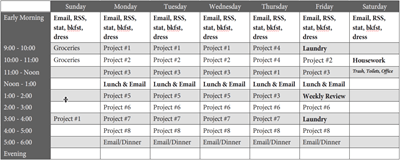As a university instructor, I often have weeks-long stretches of unscheduled time in between sessions, which I need to use to catch up on all the projects I’ve let slide during the hectic second half of the semester. As a freelance writer, I always have a stack of little projects as well as ongoing commitments (like my thrice-weekly posts here at Lifehack) that need to get done.
The Trouble with MIT’s and Contexts
While I like the idea of “Most Important Tasks” (MITs) — where you write down the three or four things you absolutely must get done each day, and work on those first, leaving everything else for whatever time is left over at the end — the fact is that a lot of my commitments can’t be handled that way. I’ve got more than three ongoing commitments, each of which needs at least a little attention every day. I also find that contexts in the GTD sense don’t really work for me — yes, all of these tasks might be alike in that they happen at my computer, but they require different mindsets. I try to batch things like phone calls and emails, when I can, but for the rest of my work, that doesn’t really work. To finish a writing task, for example, I might need to sit and read a little, write notes and thoughts by hand on paper for a while, and then sit at the computer and work — before heading back to the sofa for some more reading.
Time Striping: Like Time Blocking, But Stripier
What works for me is a variation on time blocking that I’m calling “time striping”. In time blocking, you schedule uninterrupted “blocks” of time for different projects across your schedule. Since a) many of my projects are ongoing, and b) some projects emerge rather suddenly, I need a little more flexibility than that. So what I’ve done is created a loose schedule where each hour is dedicated to a generic project, i.e. “Project #1”, “Project #2”, etc. As I finish a project, I slot a new project into its timeslot; if Project #5 only takes an hour, then tomorrow it will be something different. It’s conceivable that a particular time block will be used for 5 different projects over the course of the week. Each slot, then, creates a “stripe” of time from Monday to Friday. In some cases, where I know I need more than 1 hour for a project, I’ll block off two hours or more and flow the rest of my projects around it. For instance, every other Thursday morning I record Lifehack Live, and I need two hours to prepare, record, and write up my notes. So that’s a block, instead of a stripe.
The Time Striping Form (with variations)
If you’re wondering what this all looks like, I’ve thrown together a generic version of the form that I use, which you can download. The first is a PDF you can print out using Adobe Reader or any other PDF reader; the second is an RTF file that you should be able to open and edit with almost any word processor (although in my tests, the formatting differs greatly from app to app; I got good results from Word 2007 and WordPad, and terrible results from OpenOffice.org 2). Here are the files:
Time Striping Form in editable RTF Time Striping Form in PDF
At the top is space to put any fixed commitments for the week. The bottom table is your key, with space to define up to 10 projects; as you finish a project, cross it off and fill in the next box with the new project for that space. The middle is an hour-by-hour schedule for the week, with one-hour slots from 9-6. (You can change the working hours or start the calendar on Monday by editing the RTF.) Generally, you’ll put “Project #1” in at 9-10am and draw a line all the way across (or fill it in on each day); if you need two hours, just repeat “Project #1” in the 10-11am slot. Here’s how my schedule looks (click for a larger view):
Since I’m a slow waker, I’ve set aside the first three hours to check my email, look at feeds, check my site stats, have breakfast, and get dressed for the day. At 9, my workday starts — Project #1 is Lifehack, so I’ll work on posts, brainstorm ideas, do site maintenance, and whatever else I need to do. At 10, I move onto my next project, which at the moment is editing an e-book I’m going to release this summer. When I finish that, I’ll replace Project #2 with something else. Project #3 is preparing an online course I’m teaching this summer. And so on. You’ll note that around Thursday it breaks up; I need two hours for Lifehack Live, so I take that time from Project #2; on Friday, I’ve scheduled time to do laundry and other housework, and my weekly review. At the start of the week, then, I was careful to assign slots that wouldn’t get 5 hours to smaller projects. Notice, too, that I’ve added three email times per day. Let to my own devices, I’d check email constantly throughout the day; this is my way of reminding myself to stick to the task at hand and check email right before I break for lunch and at the very end of my working day before I go to make dinner. The benefit of all this is that I can see at a glance how much time I’ve set aside for each project over the course of the week. If something new comes up, I can easily replace a project slot (or more, if necessary) with it and re-allot time as necessary. I’ve only got 8 projects on there; the last two are for family projects and would go in the weekend or evening time slots; at the moment, I don’t have any.
Maybe This Will Work for You?
Time striping won’t seem all that new to people who are already practicing time blocking — the only difference is that I try to keep the same projects at the same time every day, and the flexibility of having slots dedicated to generic projects instead of particular ones. That’s what works for me, and I think it might work well for some of you out there who are having a hard time getting a grip on your schedule. Let me know if this is helpful, or if you have your own slightly off-beat way of working through your various projects.

